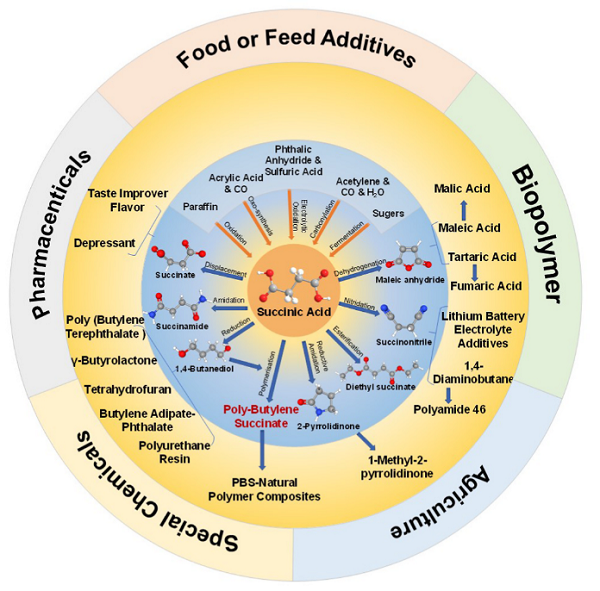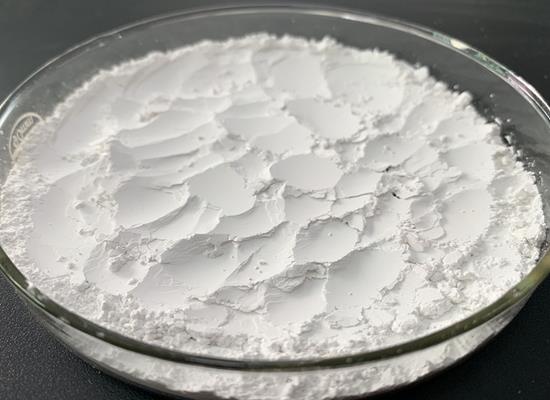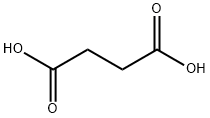The synthesis method of Succinic acid
Apr 29,2024
Introduction
Succinic acid, a four-carbon dicarboxylic acid, is an important C4 platform compound. It is a key intermediate in synthesizing many commercially essential chemicals, such as adipic acid, 1,4-butanediol, tetrahydrofuran, N-methyl pyrrolidone, 2-pyrrolidone, and γ-butyrolactone. The US Department of Energy ranked succinic acid first among the “12 bio-based platform compounds” in 2004. Succinic acid has a wide range of uses and a high added value. It can be used as a raw material to produce daily necessities and specialty chemicals. As an example of the current research hotspot, poly (butylene succinate) (PBS) is formed by co-polymerizing succinic acid and 1,4-butanediol. The polymer has good mechanical properties, processability, durability, biodegradability, and environmental compatibility. Hence, the research on the synthesis of Succinic acid is very hot[1].

It is currently being produced from crude oil-based feedstock but can be produced by microbial conversion of lignocellulosic biomass. The most promising method reported is the production of succinic acid from Escherichia coli AFP184, as it can utilize both xylose and glucose. Numerous separation techniques may be applied to purify succinic acid, most of which are related to three separation processes: electrodialysis, reactive extraction, and filtration.
A. succinogenes
As a price-stable and economically sustainable method of succinic acid production, biofermentation is undoubtedly the best choice. Many microorganisms, including A. succinogenes, Anaerobiospirillum succiniciproducens, Man nheimia succiniciproducens, and Basfia succiniciproducens, are naturally capable of producing succinic acid. Genetic engineering has also used some other strains to produce succinic acid. A. succinogenes 130Z (ATCC No.55618), first isolated by Guettler et al. (1996) and native to the bovine rumen, belongs to Pasteurellaceae taxonomically according to its 16 S rRNA sequence. This organism is one of the most efficient natural producers of succinic acid.
A. succinogenes can produce succinic acid with high concentration and high yield from pure glucose and glucose-rich substrates and various carbon sources. It has the potential to utilize complex feedstocks, including monosaccharides (glucose, fructose, xylose, arabinose, galactose, mannose), disaccharides (lactose, sucrose, cellobiose, maltose), mannitol, and sorbitol. The above indicates its ability to withstand extreme environments, of offering the promise of A. succinogenes as a biological platform candidate. This bio-succinic acid production using A. succinogenes has the advantages of high product concentration, abundant raw material sources, easy separation, and high product quality. It can use glucose, starch saccharification solution, cellulose/ hemicellulose hydrolyzed sugar solution as carbon sources and fix CO2 gas in fermentation. A high concentration of succinic acid could still be achieved under a higher glucose concentration (100 g/L). Current R&D focuses on the development of strains and processes that are industrially competitive in terms of productivity, yield, and succinic acid production.
Energy crops
Among wood, cereals, or perennial herbaceous crops, those grown specifically to meet global energy needs are referred to as energy crops. Several publications have reported the low-cost production of bio-succinic acid by A. succinogenes from energy crops under anaerobic conditions. Using the dilute acid hydrolysate of the non-food crop Je rusalem artichoke tuber, succinic acid was produced by batch fermenta tion with A. succinogenes 130Z. Simultaneous fermentation of fructose and glucose in tuber hydrolysate to succinic acid was observed without adding a nitrogen source or other nutrients. Moreover, as Jerusalem artichoke does not contain any xylose, furfural will not be formed, facilitating the subsequent steps.
Electrodeionization
Biotechnological conversion requires the separation and purification of the main product. In the case of carboxylic acids, an additional problem is the alkaline environment of the subculture of microorganisms and, consequently, the need to convert the carboxylate formed into the free acid form of the product[2]. Methods such as extraction or esterification do not separate the carboxylate. Acidification of fermentation broths with inorganic acids generates large fractions of waste. This is not only inconsistent with the principles of sustainable technology but also increases the cost of the process. Succinate conversion is possible through ion exchange or electrodialysis. However, these methods have limitations and drawbacks that reduce the efficiency of the process. A potential solution to these limitations is the application of electrodeionization (EDI) as a downstream stage in the bioproduction of carboxylic acids technology. Aqueous solutions of disodium succinate (pH 6.8) were converted into the electro-deionization module. In the final product of succinic acid, the residual sodium was determined at a level of 4% (conversion efficiency 96%). Strengthening the potential of biotechnological processes and their competitiveness in relation to fossil fuel conversion through the possibility of using electro-deionization in downstream processing.
References
[1] Yan Yang . “Progress on production of succinic acid by Actinobacillus succinogenes – New opportunities for cheap biomass and waste gas utilization.” Journal of Cleaner Production 434 (2023): Article 140005.
[2] Beata Rukowicz*, “Electrodeionization for the Bio-Succinic Acid Production Process.” ACS Sustainable Chemistry & Engineering (2023).
- Related articles
- Related Qustion
- Succinic Acid: Solubility and Mechanism of Action Nov 22, 2022
The passage introduces the solubility and mechanism of action of succinic acid.
- Uses and Preparation of Succinic acid Mar 31, 2022
Succinic acid(SA) is an alpha,omega-dicarboxylic acid resulting from the formal oxidation of each of the terminal methyl groups of butane to the corresponding carboxy group.
Supplementation with pyridoxal 5'-phosphate monohydrate can synthesize neurotransmitters such as dopamine and serotonin, maintaining a healthy nervous system.....
Nov 4,2025Biochemical EngineeringD-Proline, vital in pharmaceutical synthesis, aids in drug creation, especially in asymmetric synthesis and peptide-based development, advancing pharmaceutical research.....
Apr 30,2024APISuccinic acid
110-15-6You may like
- Succinic acid
-

- 2025-12-11
- CAS:110-15-6
- Min. Order:
- Purity: 0.99
- Supply Ability:
- Succinic Acid
-

- $10.00 / 1PCS
- 2025-12-11
- CAS:110-15-6
- Min. Order: 1PCS
- Purity: 99%
- Supply Ability: 10 mt
- Succinic acid
-

- $0.00 / 25kg
- 2025-12-11
- CAS:110-15-6
- Min. Order: 1kg
- Purity: 99%
- Supply Ability: 8000MT






